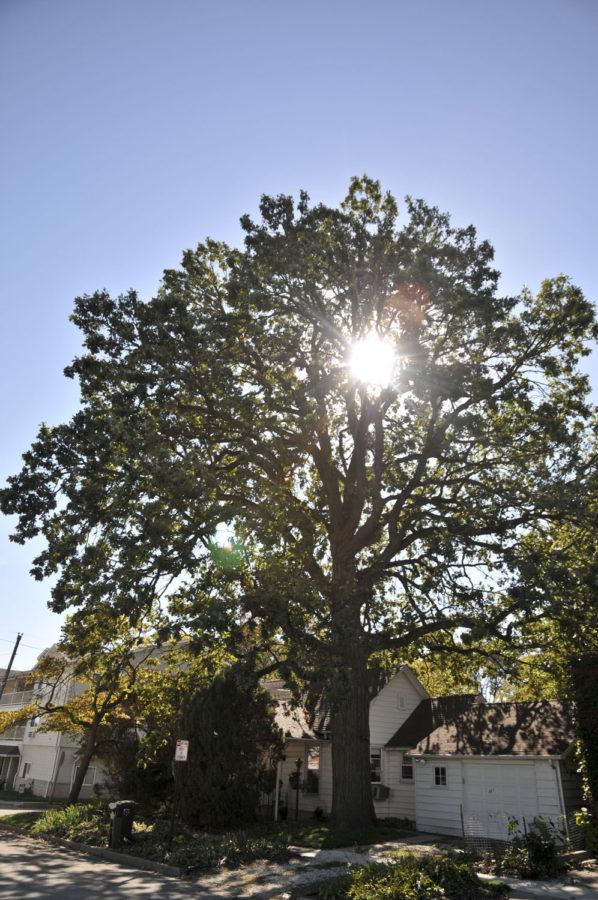Falling an hour back for daylight saving time
Light peeks behind the first living Legacy Tree, a bur oak, is located at 301 Griggs St. in Urbana. Students now have an extra hour to sleep because of daylight saving time.
Nov 4, 2013
This weekend marked the end of many things, such as the month of October, Halloween celebrations and midterm mania. One ending that goes along with this is daylight saving time, which concluded Sunday at 2 a.m.
English builder William Willett first proposed daylight saving time in 1907 in his pamphlet, “The Waste of Daylight.” In the pamphlet, Willett discussed moving up the time 80 minutes between the months of April and October, so people could enjoy more daylight hours and potentially conserve energy.
Willett’s idea was adopted during World War I, first by Germany in 1916 and then by Great Britain and the United States. Both the Allied and Axis Powers were attempting to conserve resources as much as possible.
Initially, daylight saving time was seen as disruptive by many in the U.S. and was soon repealed. The practice was put in effect again during World War II. After that, there were no regulations on daylight saving time, so states and cities could practice it how they pleased.
However, this made travel to different cities complicated, so in 1966 the Uniform Time Act was passed. This regulated when the practice would begin and end nationwide. If a state, city or town did not want to participate, it filled out an ordinance, according to nationalatlas.gov.
Get The Daily Illini in your inbox!
Professor Eric Snodgrass, director of undergraduate studies in the department of atmospheric science, has studied the history of daylight saving time because it affects weather forecasting. Through his research, he has found common misconceptions and little known facts about the practice.
“A mispronunciation about daylight saving time is a lot of people like to call it daylight savings time, and there is no ‘s,’” Snodgrass said.
Snodgrass also theorized that one reason for Willett’s proposing daylight saving time was because he wanted there to be sunlight remaining so he could golf after work.
Additionally, not all states in the U.S. use daylight saving time today. Hawaii, Arizona and territories like Puerto Rico do not participate because they have more consistent daylight during the year.
The practice of daylight saving time has many pros and cons. For example, people monitoring the weather use “zulu” time, a 24-hour clock set on the prime meridian. This universal time system does not obey daylight saving time so they must adjust one hour, Snodgrass said.
The end of daylight saving time also means that it will be darker outside earlier at night. Catherine Beauboeuf, junior in Engineering, said she does not like how the practice affects her studying habits at the library.
“I get tired easily, and it is harder to focus, and I have to walk home in the dark,” Beauboeuf said.
Beauboeuf is not the only student who feels this way.
“I feel like the day is over (sooner) and no more productivity can happen,” said Andre Eagle, senior in LAS.
Similarly, Yuhe Liu, graduate student in ACES, said daylight saving time ending makes him want to go home early.
Despite these problems, Snodgrass argues that daylight saving time should be preserved.
“Some studies have been done to see if using daylight saving time has helped with traffic accidents, and what they determined is there is a one to two percent reduction in traffic accidents … (and) a five percent reduction in car-to-pedestrian traffic accidents,” Snodgrass said.
Additionally, by “falling back” an hour, parents will not have to worry about their children standing out at bus stops in the dark, Snodgrass said.
Despite differing opinions on daylight saving time, it is a transition, or a new beginning, that people must adjust to each year. And come March 9, the clock will “spring forward” again.
As you observe the ending of daylight saving time, here is a scenario from Professor Snodgrass to think about:
“Let’s say that a woman was in the hospital, and she was delivering twins this Saturday night. … (At) 1:58 a.m. on Sunday morning, the first twin arrives. Four minutes later, the second twin arrives. But because of daylight saving time ending, that is now 1:02 a.m. on the same day. When you write it down, you are going to have a kid who was born at 1:58 a.m. … and then you’re going to have another kid born at what would have been 2:02 a.m. but is now 1:02 a.m. … (One) is younger, but on paper looks older. … What happens?”
Snodgrass does not have an answer.
Annabeth can be reached at [email protected].



